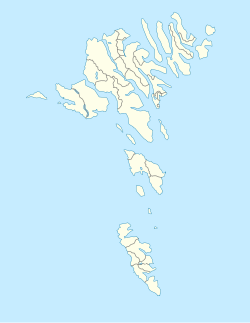You can help expand this article with text translated from the corresponding article in Faroese. (October 2022) Click [show] for important translation instructions.
|
Kirkja (Danish: Kirke) is a village on the island of Fugloy, Faroe Islands. It is located on the south-tip of the island, and its land is stretching all over the western side of the island, including a small enclave in the now uninhabited Skarðsvík. Here archaeologists have located an old settlement that has probably been only a part-time settlement used either by people from Kirkja or Hattarvík.
Kirkja | |
|---|---|
 Kirkja on Fugloy | |
| Coordinates: 62°19′10″N 6°18′51″W / 62.31944°N 6.31417°W | |
| State | |
| Constituent country | |
| Island | Fugloy |
| Municipality | Fugloyar kommuna |
| Population (Nov 2020)[1] | |
• Total | 30 |
| Time zone | GMT |
| • Summer (DST) | UTC+1 (EST) |
| Postal code | FO 766 |
| Climate | Cfc |
Transportation
editKirkja is one of two villages on the island of Fugloy that are connected both by the road built in the 1980s and by the ferry that connects both Kirkja and Hattarvík to Hvannasund on the larger island of Viðoy, and in the last two decades the island can also be reached by helicopter either from the national airport in Vágar, the national capital of Tórshavn or the regional capital Klaksvík.
Kirkja means church and Fugloy means bird-island in Faroese. From here there is a view over the sound Fugloyarfjørður towards the capes of Svínoy and also towards the northernmost cape of the Faroes, Enniberg on Viðoy – one of the highest cliffs in the world – and the rounded isthmus of Viðareiði that has been a favorite motif for Faeroese and foreign painters throughout the past century because of its tremendously beautiful sunset. Kirkja thereby offers panoramas in the Faroes, making it a tourist attraction.
Climate
edit| Climate data for Kirkja, Fugloy, 53 m.a.s.l. | |||||||||||||
|---|---|---|---|---|---|---|---|---|---|---|---|---|---|
| Month | Jan | Feb | Mar | Apr | May | Jun | Jul | Aug | Sep | Oct | Nov | Dec | Year |
| Record high °C (°F) | 13.4 (56.1) |
12.0 (53.6) |
13.0 (55.4) |
14.9 (58.8) |
19.8 (67.6) |
20.0 (68.0) |
21.3 (70.3) |
20.8 (69.4) |
20.6 (69.1) |
18.8 (65.8) |
13.0 (55.4) |
14.5 (58.1) |
21.3 (70.3) |
| Mean daily maximum °C (°F) | 6.7 (44.1) |
5.8 (42.4) |
6.5 (43.7) |
7.2 (45.0) |
9.2 (48.6) |
11.2 (52.2) |
12.8 (55.0) |
13.4 (56.1) |
11.8 (53.2) |
9.5 (49.1) |
7.5 (45.5) |
6.6 (43.9) |
9.0 (48.2) |
| Daily mean °C (°F) | 4.6 (40.3) |
3.7 (38.7) |
4.3 (39.7) |
5.2 (41.4) |
7.0 (44.6) |
9.0 (48.2) |
10.6 (51.1) |
11.2 (52.2) |
9.7 (49.5) |
7.5 (45.5) |
5.8 (42.4) |
4.4 (39.9) |
6.9 (44.4) |
| Mean daily minimum °C (°F) | 2.4 (36.3) |
1.5 (34.7) |
1.8 (35.2) |
2.9 (37.2) |
4.9 (40.8) |
7.0 (44.6) |
8.8 (47.8) |
9.3 (48.7) |
7.7 (45.9) |
5.5 (41.9) |
3.8 (38.8) |
2.2 (36.0) |
4.8 (40.6) |
| Record low °C (°F) | −6.2 (20.8) |
−5.5 (22.1) |
−9.1 (15.6) |
−4.2 (24.4) |
−2.4 (27.7) |
1.5 (34.7) |
4.1 (39.4) |
4.9 (40.8) |
0.9 (33.6) |
−2.0 (28.4) |
−3.2 (26.2) |
−6.2 (20.8) |
−9.1 (15.6) |
| Average precipitation mm (inches) | 94 (3.7) |
87 (3.4) |
94 (3.7) |
84 (3.3) |
67 (2.6) |
66 (2.6) |
80 (3.1) |
83 (3.3) |
85 (3.3) |
111 (4.4) |
97 (3.8) |
93 (3.7) |
1,040 (40.9) |
| Average precipitation days (≥ 1.0 mm) | 18 | 17 | 18 | 12 | 13 | 9.8 | 9.7 | 13 | 15 | 17 | 18 | 15 | 175 |
| Source: Danish Meteorological Institute[2] | |||||||||||||
See also
editReferences
edit- ^ "Changes in population, by village/city, month, immigration and emigration". Hagstova Føroya. Archived from the original on 2009-11-13. Retrieved 2009-10-14.
- ^ "The Climate of The Faroe Islands - with Climatological Standard Normals, 1961-1990 Greenland" (PDF). Danish Meteorological Institute. Retrieved August 19, 2015.
External links
edit- Media related to Kirkja at Wikimedia Commons
- Faroeislands.dk: Kirkja Images and description of all cities on the Faroe Islands.
